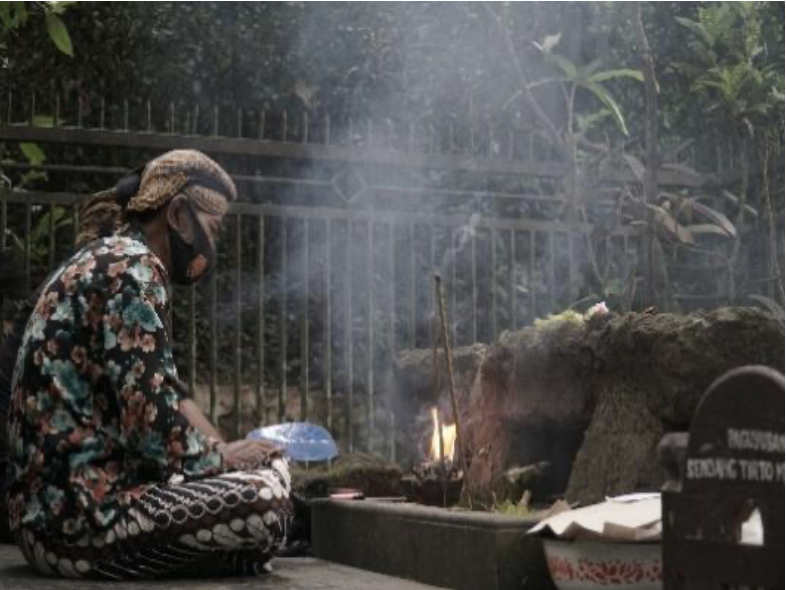Abstract
This research aims to elucidate the reason behind the decline of villagers’ enthusiasm toward the Ulur-ulur ritual. Ulur-ulur ritual is a surviving agrarian ritual that was initially an integral part of and executed by four villages, including the Village of Sawo, Ngentrong, Gedangan, and Gamping Tulungagung Regency, as a manifestation of gratitude for the water of Buret Lake sustaining local’s agricultural activity. Historically, this ritual was dying in 1965, then revitalized in 1966 by the Paguyuban Sendang Tirto Mulyo. Currently, despite being set as the annual agenda of Tulungagung Tourism and officially acknowledged as an intangible cultural heritage by the Ministry of Education and Culture of Indonesia in 2020, the villagers' enthusiasm remains low. To uncover this phenomenon, this research employed an ethnographic approach. In-depth interviews and participatory research were executed to obtain data. The result showed that the ritual was constructed and operated by two memories: dhanyangan (ancestral spirit) and agricultural memories. However, the impact of the G-30-S tragedy escalated the tension in the society leading to the vandalism of the Sri-Sedono statues, which were the mnemonic device of agricultural memory. Meanwhile, the dhanyangan memory, constantly amplifying, created a clash with the more religious society’s narrative. The long vacuum period and the narrative shift make the association of ritual with the dhanyangan grow more robust, which contradicts the current social context. Furthermore, the revitalization, which was merely rooted in “defeated memory” led to the exclusion of the ritual from society.References
Assmanm, J. (2008). Communicative and Cultural Memory in Cultural Memory Studies. In An International and Interdisciplinary Handbook (Astris Erl, pp. 109–118). Walter de Gruyter.
Bandur, A. (2016). Penelitian Kualitatif, Metodologi, Desain, dan Teknik Analisis Data dengan NVIVO 11 Plus. Mitra Wacana Media Penerbit.
Dewi, T. K. S. (2009). Transformasi Mitos Dewi Sri dalam Masyarakat Jawa. Universitas Indonesia.
Galtung, J. (1996). Peace by Peaceful Means: Peace and Conflict, Development and Civilization. Sage Publications, Inc.
Geertz, C. (1960). Agama Jawa: Abangan, Santri, Priyayi Dalam Kebudayaan Jawa. Komunitas Bambu.
Hobsbawm, E. (1983). The Invention of Tradition. Cambridge University Press.
Hymes, D. (2004). Ethnography, Linguistic, Narrative Inequality. Taylor&Francis.
Jones, A. (2007). Memory and Material Culture. Cambridge University Press.
Kuswarno, E. (2011). Etnografi Komunikasi Suatu Pengantar dan Contoh Penelitiannya. Widya Padjadjaran.
Meer, V. S. van der, & Claire, N. (1979). Sawah Cultivation in Ancient Java Aspects of Development during the Indo-Javanese Period, 5th To 15th Century. In Australian National University Press.
Mulyana, D. (2018). Metodologi Penelitian Kualitatif: Paradigma Baru Ilmu Komunikasi dan Ilmu Sosial Lainnya. In Bandung: Remaja Rosda Karya. Remaja Rosdakarya.
Paguyuban Sendang Tirto Mulyo. (2006). Ulur-ulur Upacara Tradisional di Desa Sawo. Tulungagung. Sekretariat Paguyuban Sendang Tirto Mulyo.
Sims, M., & Stephens, M. (2011). Living Folklore an Introduction to the Study of People and Their Culture. Utah State University Pres.
Spradley, J. (2007). Metode Etnografi (The Ethnographic Interview) (ke-2). Tiara Wacana.
Tulungagung Tourism. (2019). Tulungagung Regency Map. Www.Eastjava.Com. https://www.eastjava.com/tourism/tulungagung/map.html
Wakil Bupati Tulungagung. (2018). Rencana Pembangunan Jangka Menengah Daerah (RPJMD) Kabupaten Tulungagung tahun 2018-2023.

This work is licensed under a Creative Commons Attribution-NonCommercial 4.0 International License.
Copyright (c) 2022 ETNOSIA : Jurnal Etnografi Indonesia





